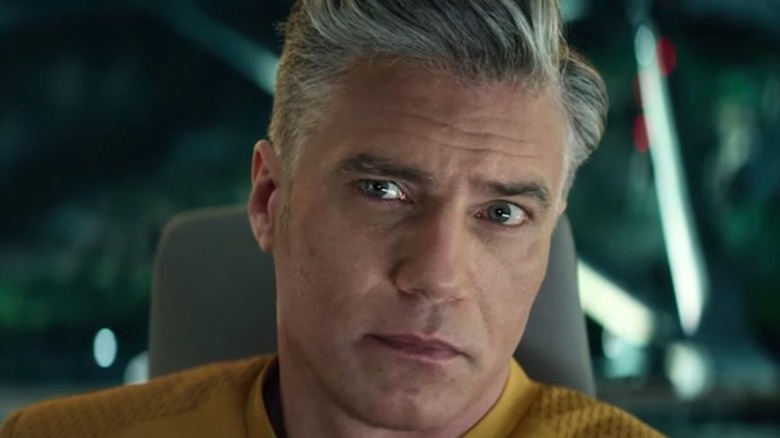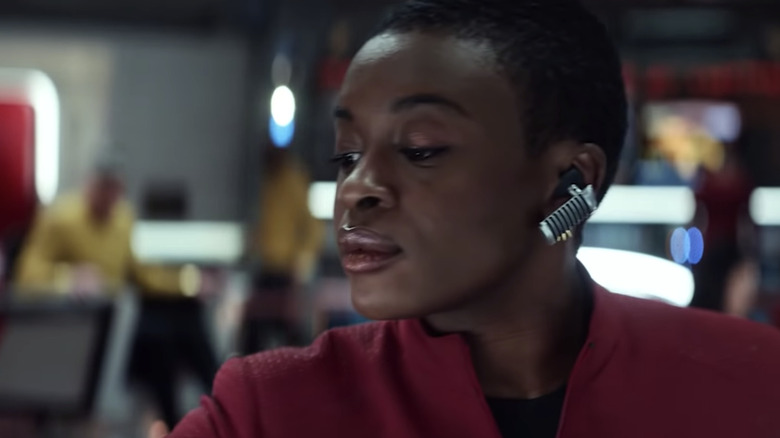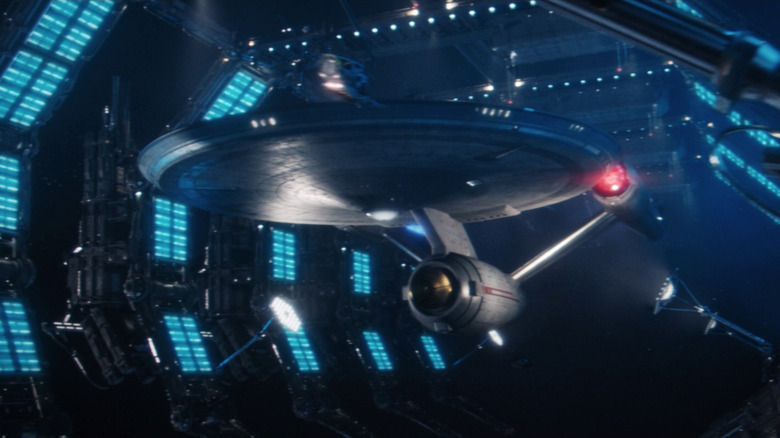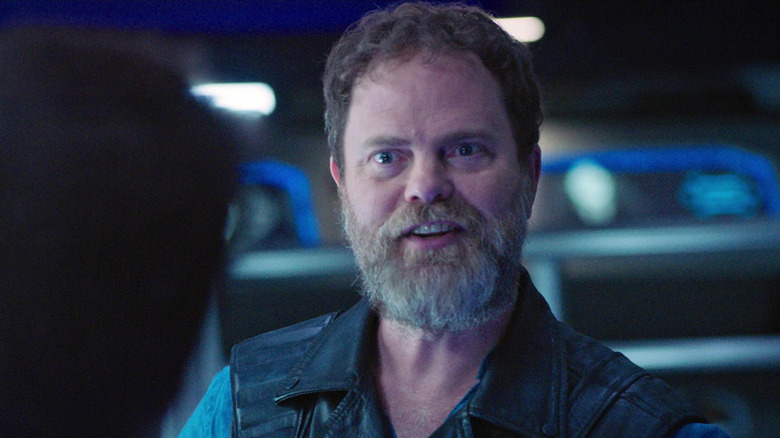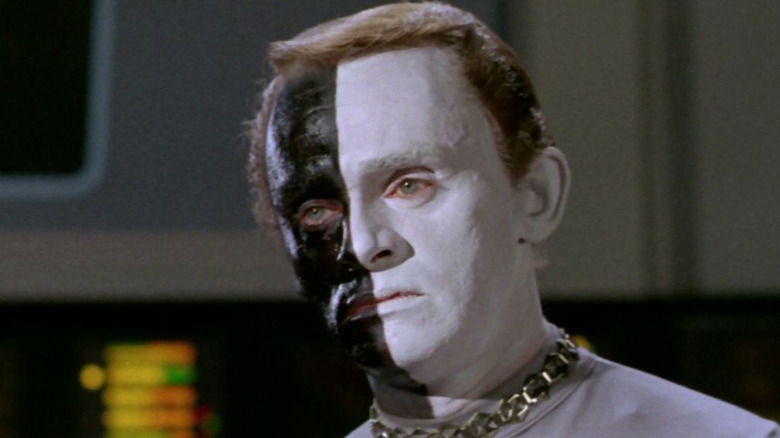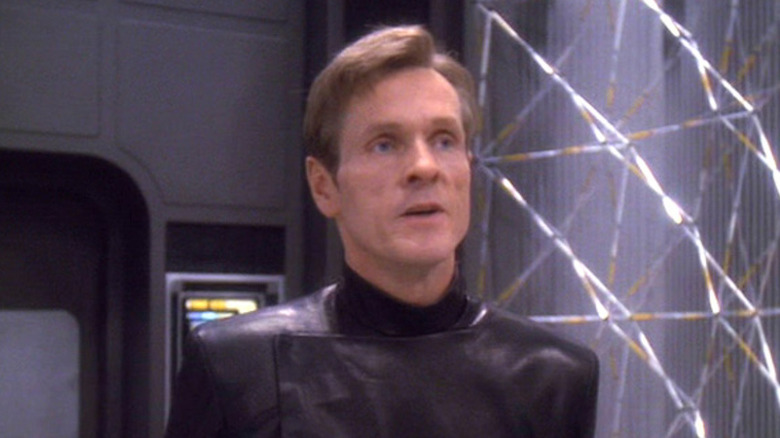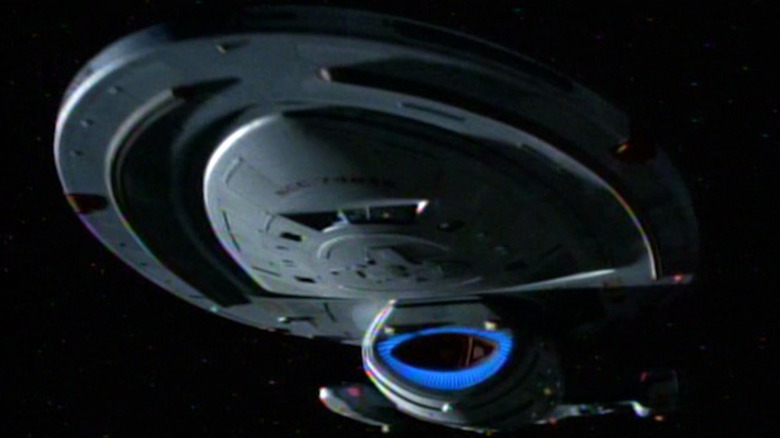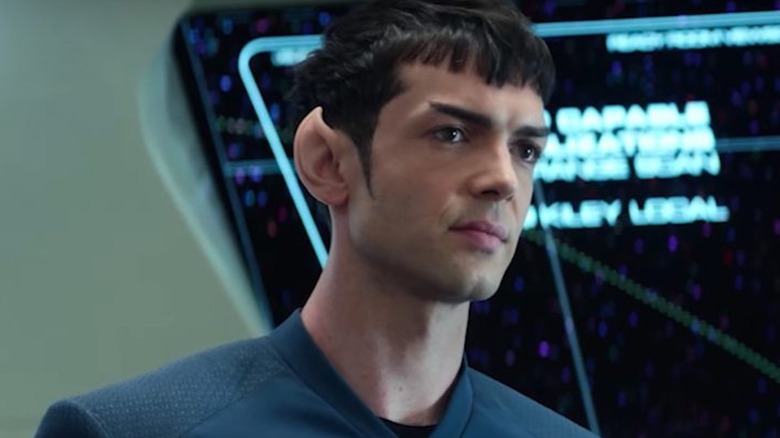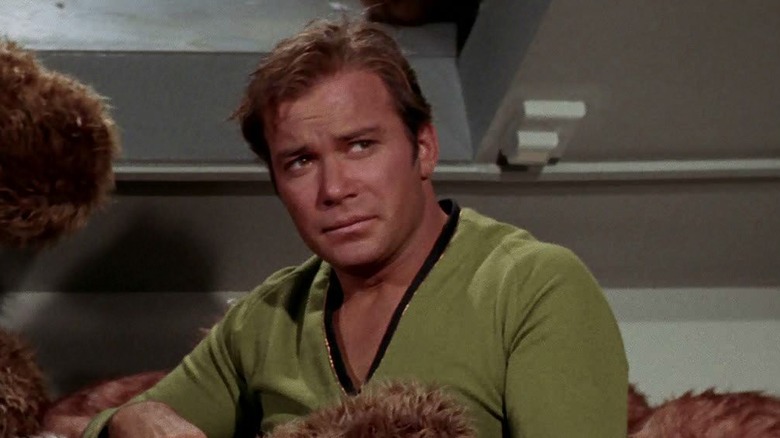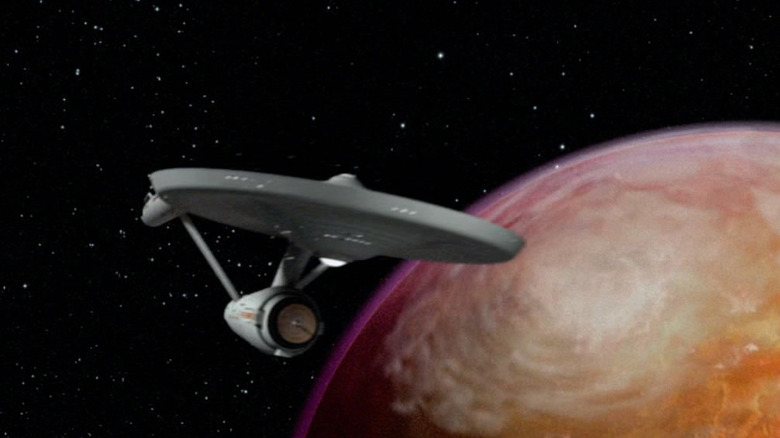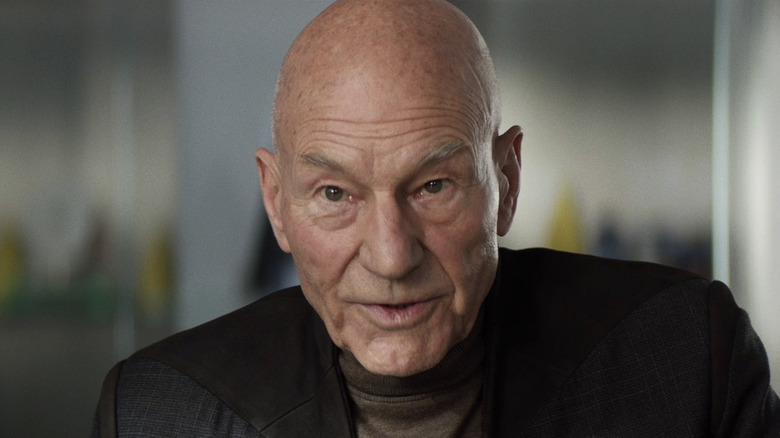Biggest Mistakes Star Trek: Strange New Worlds Should Avoid
"Star Trek" debuted on television in September 1966, launching what is now one of the most prolific media franchises in the world. But one year earlier, a version of "Star Trek" was produced, a pilot episode featuring an almost completely different cast and characters. This episode, "The Cage," stars Jeffrey Hunter as Captain Christopher Pike, Majel Barrett as First Officer "Number One," and Leonard Nimoy as Mr. Spock. NBC rejected this pilot, but was interested enough to order a second one. When Jeffrey Hunter declined to return, creator Gene Roddenberry decided to start over with a new set of characters, retaining only Nimoy's Spock.
In 2022, in what's been called "the longest pilot-to-series-pickup order in television history," the adventures of Pike, Number One, and Spock are being made into their own television series for Paramount+, entitled "Star Trek: Strange New Worlds." Spinning out of the characters' appearances on "Star Trek: Discovery," "Strange New Worlds" will be set in the years before James T. Kirk took command of the USS Enterprise and feature younger versions of a few familiar characters from "The Original Series," most notably Nyota Uhura. "Strange New Worlds" will reportedly also follow the episodic format and optimistic tone of classic "Trek."
Taking the franchise back to basics could be an easy layup for Executive Producer Alex Kurtzman and showrunners Akiva Goldsman and Henry Alonso Myers, provided they can avoid a few pitfalls common to "Star Trek" spin-offs.
Neglecting the supporting cast
The original "Star Trek" series has one of the most recognizable ensembles in television history — but when you actually go back and watch the show, it's really only Kirk, Spock, McCoy, and very occasionally Scotty who get to be the center of the story. Sulu, Uhura, and Chekov are mostly background characters who get brief moments to shine and otherwise get by on sheer charisma. "Next Generation"-era series spread the attention around a bit more, with each member of the bridge crew getting at least one focal episode per season. The most recent "Trek" dramas have leaned more heavily on their lead characters, Michael Burnham and Jean-Luc Picard, respectively.
"Strange New Worlds" seems to be taking a lot of stylistic cues from "The Original Series," but this is one area in which it would be much better off emulating the "Next Gen" format. Since "Strange New Worlds" will reportedly tell more episodic stories than "Discovery" or "Picard," the writers' room should make sure to rotate the focus between its nine-person ensemble, not only the triumvirate of Pike, Spock, and Number One. Seriously, after 55 years of waiting, you can't add Uhura to the cast and then not give us a straight-up "Uhura episode."
Being too precious about canon
While this has become true of fans of all stripes from across pop culture over the past few decades, Trekkies in particular have a reputation for being real sticklers about continuity. And, sure, making certain the rules of the world are reliable and that the characters have consistent behaviors and motivations is super important. What's not important is whether the props or costumes are perfectly accurate to the era of Star Trek's history in which "Strange New Worlds" takes place. So far, "SNW" is right on the money with their approach, crafting an aesthetic that evokes rather than replicates "The Original Series," pushing the glossy futurism of "Discovery" slightly towards the primary-color aesthetic of the 1960s.
In order to fully succeed, the creators of "Strange New Worlds" will have to carry this philosophy forward conceptually as well as visually, keeping what works, ignoring what doesn't. This may sound like heresy, but it's actually the way "Star Trek" has done things from the beginning. In the earliest episodes, Spock was a "Vulcanian" serving on the "United Earth Ship" Enterprise. Before "Star Trek III" switched them around, Klingons were famously deceitful while Romulans had a strict code of honor. The Borg had no social hierarchy, and now they have a queen. These things are not as sacrosanct as they seem. A dense and consistent canon can be great, but the creators of "Strange New Worlds" would be wise not to let it stifle their own creative freedom.
Leaning too hard on nostalgia
All sequels, spin-offs, and remakes are inherently driven, to a degree, by a desire to exploit an audience's attachment to the familiar, and "Strange New Worlds" is certainly no exception. "Strange New Worlds" is the franchise's most blatant nostalgia cash-in since the 2009 movie, returning the franchise to its home aboard the original USS Enterprise and populating it with familiar characters from the 1960s. We'll argue the producers of "Strange New Worlds" have already used up most of their allotted nostalgia budget on the concept alone, and from here on out they're going to have to come up with their own ideas.
If "Strange New Worlds" spends its first season revisiting worlds and cultures from existing "Star Trek" series, playing host to already-established guest characters, or doing prequel stories providing backstory for events that take place on "The Original Series," "The Next Generation," or later, this will stifle the development of its own identity. Even following up too often on "Discovery," the series of which "Strange New Worlds" is a direct spin-off, would likely be a mistake. That's not to say that they can't ever have the likes of Harry Mudd, Ash Tyler, or T'Pol show up (she'd only be 180, it could happen), they just have to give us time to fall in love with the new show first.
The title is "Strange New Worlds," after all — if the worlds aren't new, why bother?
Playing it too safe politically
From its inception, "Star Trek" has used the artifice of science fiction to tell stories that play as allegories to the social and political dilemmas of its time. In the 1960s, a television drama could not get away with tackling divisive issues like racial oppression or Cold War xenophobia head-on, but they could approach them by creating alien cultures who suffered from the same problems and having the USS Enterprise pay them a visit. While these alien worlds represent some of our worst social ills, the future of humanity represented by the Enterprise crew has already grown past them, providing a contrasting example of our better nature. This tradition continued through the spin-offs that aired in the '80s and '90s.
"Strange New Worlds'" sister series "Discovery" and "Picard" haven't shied away from political allegory, but they're also serialized shows that are more focused on developing character and expanding the "Star Trek" mythology. ("Lower Decks," on the other hand, is mostly interested in commenting on "Star Trek" itself.) As a more traditional, episodic "Star Trek" series, "Strange New Worlds" is best equipped to take on an "issue of the week," and if the producers want to carry on the "Trek" tradition, they're going to have to be fearless in their choice of topics and radical in their positions. They cannot shy away from issues that seem "too hot to handle," or be afraid of putting off closed-minded viewers.
Perpetuating the cynical take on Starfleet
One of the core ideas behind "Star Trek" is that humanity's future is bright — that things will get better, and that they'll be better because we will become better. Our lens into this idealized society is Starfleet, where humanity's best and brightest unite with people from a rich variety of worlds and cultures in the pursuit of diplomacy and scientific discovery. At its best, Starfleet is a symbol of peace, hope, and curiosity.
As the "Star Trek" universe expanded, the storytellers' appetites for more complex stories and more formidable antagonists gradually eroded the idea of Starfleet as an institution worth believing in. In 1997, "Deep Space Nine" introduced Section 31, an amoral secret intelligence agency who does the dirty work so that Starfleet can maintain their illusion of righteousness. Ever since, Starfleet has been depicted as corrupt or cowardly more often than not, forcing the protagonists to push back against Starfleet in order to do what's right.
This makes for compelling TV, but it betrays the optimism upon which "Star Trek" is based. Of course it's more realistic to depict a quasi-military organization that represents a powerful nation-state as corrupt and self-serving. That's usually how it works. The premise of "Star Trek" is, basically, "What if that wasn't how it worked?" We're not suggesting that all "Star Trek" shows from now on have to paint Starfleet as saintly, but if "Strange New Worlds" seeks to be a more hopeful take on the franchise, that might be a good place to start.
Abusing the magic reset button
"Star Trek" took its time graduating from the then-customary episodic TV format to the serialized model that we're accustomed to today, and there were some serious growing pains. For instance, "Voyager" had a premise that was ripe for serialization, the saga of a starship surviving on its own in a far-off corner of space, but instead leaned into the episodic nature of traveling in a straight line towards home, never visiting the same world twice. That sounds all well and good, except that the Starship Voyager herself often takes serious damage over the course of an episode, and despite being thousands of light years from the nearest Federation starbase, is somehow always in perfect condition by next week. Likewise, the circumstances of their journey sometimes involve serious trauma for the crew, but by the later seasons nothing seemed to stick. This gave birth to the myth of the "magic reset button" that Captain Janeway could press each time the end credits rolled that essentially erased whatever had just happened from history.
"Strange New Worlds" showrunner Akiva Goldsman has assured fans that, episodic or not, there will be no reset button on the new series. Plots may wrap up in the space of 50 minutes, but they'll have a lasting effect on the characters. This is not a lot to ask and perhaps the area in which the show is least likely to disappoint, but failure here could hurt the show very badly.
Overdeveloping Spock
Spock is arguably the most iconic "Star Trek" character, as famous for his stoic, logical demeanor as for his pointed ears. When Spock joins the ensemble of "Star Trek: Discovery" for the second half of their second season (now played by Ethan Peck), he's a bit younger, angrier, and more emotionally vulnerable than he's usually been depicted. By the time the season ends, Spock has found a degree of peace, having recovered from a traumatic mind meld and reconnected with his long-estranged foster sister, but he's still got a lot of room to grow into the character we know from "The Original Series."
"Strange New Worlds" gives Peck the chance to close that gap, to mature Spock from a volatile young man to a supremely confident, wryly funny picture of Vulcanity. (At a recent promotional event, Ethan Peck promised that "Strange New Worlds" would explore Spock's "feelings of love and attraction," which should be in interesting new territory.) But showrunner Akiva Goldsman should be careful not to let the character grow up too much, or else he may end up robbing later installments of some of their pathos. Like most of the original cast of characters, Spock develops the most in the film series, in which he finally finds a healthy balance between his human and Vulcan sides. The challenge of a "midquel" series like "Strange New Worlds" is to give Spock enough growth to keep him interesting, but not enough to take the wind out of later stories.
Losing the camp
Since 2009, writer/producer Alex Kurtzman and company have put a lot of effort into making "Star Trek" into something approaching "cool." But go back and watch the original "Star Trek," and you'll notice pretty quickly that this stuff is also very silly sometimes. Much of that silliness has been lost from live action "Trek" in recent years, as the franchise aims for a more sober, self-serious tone. We're not suggesting that this doesn't work just fine for "Discovery" and "Picard," but if Kurtzman and company are interested in making "Strange New Worlds" sufficiently different from its recent predecessors, this would be a great way to do it.
The episodic structure may also be more conducive to telling sillier stories, since conflicts don't have to be so complex and stakes don't have to be quite as high. We love "The Trouble With Tribbles," but can you imagine trying to sustain that plot for 10 hour-long episodes? No thanks. One-and-done installments can much more easily allow for an occasional comedy episode, in the fine tradition of "Tribbles," "Qpid," or "Take Me Out to the Holosuite."
Reusing the Original Series theme music
"Strange New Worlds" is a direct prequel to the original "Star Trek" series, set on the same ship with some of the same crew. With that kind of nostalgic hook attached, we completely understand if there's a temptation to lean into it and just recreate the famous 1966 opening sequence and slap a new title and cast credits on it. This would get a huge, warm response from the audience — the first time. But as the series (hopefully) grows into itself and establishes a unique identity, you're going to wish you'd given it a recognizable musical motif of its own.
For the record, a certain previous "generation" has already provided the model for the right balance of honoring the past and blazing the future. If it were up to us, we'd open the show the way "The Next Generation" did — with a fresh arrangement of just the famous fanfare from the first half of Alexander Courage's famous "Star Trek" theme, over which Anson Mount can deliver his take on the "Space, the final frontier" monologue. Then, just when we're ready to go boldly where no one has gone before, they could kick into something new — not just a rearrangement of a theme from the films, as "The Next Generation" does, but something original that's evocative and memorable.
A TV-MA rating
We're fully behind the idea that if you're going to produce five "Star Trek" shows at once, they should each appeal to a slightly different corner of the viewing audience. "Discovery" has softened a lot of its edges since it debuted as a clearly adult-oriented action-adventure drama and now feels a lot more family-friendly. "Picard," on the other hand, is plainly a show for grown-ups in which characters get their eyes gouged out on screen and aren't afraid of a well-placed F-bomb. (Picard himself hasn't dropped one yet and we hope he's been saving it for Q.)
There's nothing wrong with these approaches and neither a little saucy language nor "Lower Decks" gross-out humor is gonna hurt anybody. But just like the upcoming Nickelodeon-branded "Star Trek: Prodigy" is likely going to turn off some adults, the edgier beginnings of both of the current live-action "Trek" series might not appeal to kids, or could dissuade parents from sharing it with them. "Strange New Worlds" would do well to position itself as a "Trek" show to watch as a family.
So many Trekkies got their start watching earlier "Star Trek" series with their parents or grandparents, gradually growing into the darker and heavier episodes, series, and films as they grew up. "Strange New Worlds" could become an entry point across generations, introducing young viewers to the universe and perhaps enticing lapsed older fans to check out the other new series and see what they've been missing.
